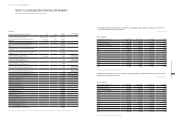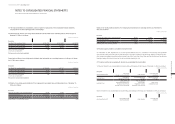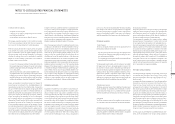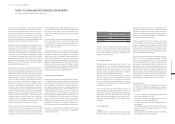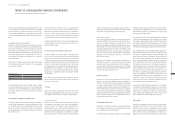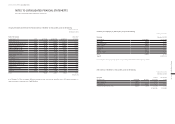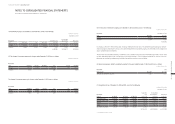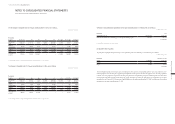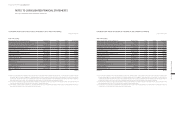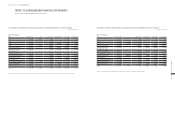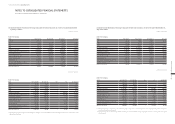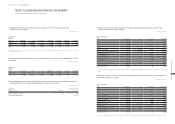Hyundai 2014 Annual Report Download - page 54
Download and view the complete annual report
Please find page 54 of the 2014 Hyundai annual report below. You can navigate through the pages in the report by either clicking on the pages listed below, or by using the keyword search tool below to find specific information within the annual report.
HYUNDAI MOTOR COMPANY Annual Report 2014
FINANCIAL STATEMENTS / 107106
ognized in profit or loss immediately, together with any changes
in the fair value of the hedged asset or liability that are attribut-
able to the hedged risk. Hedge accounting is discontinued when
the Group revokes the hedging relationship, when the hedging
instrument expires or is sold, terminated, or exercised, or when
it is no longer qualified for hedge accounting. The fair value ad-
justment to the carrying amount of the hedged item arising from
the hedged risk is amortized to profit or loss from that date.
2) Cash flow hedges
The effective portion of changes in the fair value of derivatives
that are designated and qualified as cash flow hedges is recog-
nized in other comprehensive income. The gain or loss relating to
the ineffective portion is recognized immediately in profit or loss.
Amounts previously recognized in other comprehensive income
and accumulated in equity are reclassified to profit or loss in the
periods when the hedged item affects profit or loss. If the forecast
transaction results in the recognition of a non-financial asset or
liability, the related gain and loss recognized in other comprehen-
sive income and accumulated in equity is transferred from equity
to the initial cost of related non-financial asset or liability.
Cash flow hedge accounting is discontinued when the Group
revokes the hedging relationship, when the hedging instrument
expires or is sold, terminated or exercised, or it no longer quali-
fies for the criteria of hedging. Any gain or loss accumulated in
equity at that time remains in equity and is recognized as profit
or loss when the forecast transaction occurs. When the forecast
transaction is no longer expected to occur, the gain or loss ac-
cumulated in equity is recognized immediately in profit or loss.
(25) Fair value
Fair value is the price that would be received to sell an asset
or paid to transfer a liability in an orderly transaction between
market participants at the measurement date, regardless of
whether that price is directly observable or estimated using an-
other valuation technique. In estimating the fair value of an as-
set or a liability, the Group takes into account the characteristics
of the asset or liability if market participants would take those
characteristics into account when pricing the asset or liability
at the measurement date. Fair value for measurement and/or
disclosure purposes in these consolidated financial statements is
determined on such a basis, except for leasing transactions that
based on the best estimate of amounts necessary to settle the
present and future warranty obligation.
3) Defined benefit plans
The Group operates defined retirement benefit plans. Defined
benefit obligations are determined at the end of each report-
ing period using an actuarial valuation method that requires
management assumptions on discount rates, rates of expected
future salary increases and mortality rates. The characteristic
of post-employment benefit plan which serves for the long term
period causes significant uncertainties when the post-employ-
ment benefit obligation is estimated.
4) Taxation
The Group recognizes current tax and deferred tax based on
the best estimates of income tax effect to be charged in the
future as the result of operating activities until the end of the
reporting period. However, actual final income tax to be charged
in the future may differ from the relevant assets and liabilities
are within the scope of K-IFRS 1017 ‘Leases’, and measure-
ments that have some similarities to fair value but are not fair
value, such as net realisable value in K-IFRS 1002 ‘Inventories’
or value in use in K-IFRS 1036 ‘Impairment of Assets’.
In addition, for financial reporting purposes, fair value mea-
surements are categorized into Level 1, 2 or 3 based on the
degree to which the inputs to the fair value measurements are
observable and the significance of the inputs to the fair value
measurement in its entirety, which are described in Note 19.
(26) Significant accounting judgements and key sources of
estimation uncertainties
In the application of the Group’s accounting policies, manage-
ment is required to make judgments, estimates and assump-
tions about the carrying amounts of assets and liabilities that
cannot be identified from other sources. The estimation and
assumptions are based on historical experience and other fac-
tors that are considered to be relevant. Actual results may be
different from those estimations. The estimates and underlying
assumptions are continually evaluated. Revisions to accounting
estimates are recognized in the period in which the estimate is
revised if the revision affects only that period or in the period
of the revision and future periods if the revision affects both
current and future periods.
The main accounting estimates and assumptions related to the
significant risks that may make significant changes to the car-
rying amounts of assets and liabilities after the reporting period
are as follows:
1) Goodwill
Determining whether goodwill is impaired requires an estimation
of the value in use of the cash-generating units to which good-
will has been allocated. The value in use calculation requires the
management to estimate the future cash flows expected to arise
from the cash-generating unit and a suitable discount rate in
order to calculate present value.
2) Warranty provision
The Group recognizes provisions for the warranties of its prod-
ucts as described in Note 2.(20). The amounts are recognized
recognized at the end of the reporting period and the differ-
ence may affect income tax charged or credited, or deferred tax
assets and liabilities in the period in which the final income tax
determined.
5) Fair value of financial instruments
The Group uses valuation techniques that include inputs that
are not based on observable market data to estimate the fair
value of certain type of financial instruments. The Group makes
judgements on the choice of various valuation methods and as-
sumptions based on the condition of the principal market at the
end of the reporting period.
6) Measurement and useful lives of property, plant, equipment
or intangible assets
If the Group acquires property, plant, equipment or intangible
assets from business combination, it is required to estimate the
fair value of the assets at the acquisition date and determine the
useful lives of such assets for depreciation and amortization.
NOTES TO CONSOLIDATED FINANCIAL STATEMENTS
AS OF AND FOR THE YEARS ENDED DECEMBER 31, 2014 AND 2013



